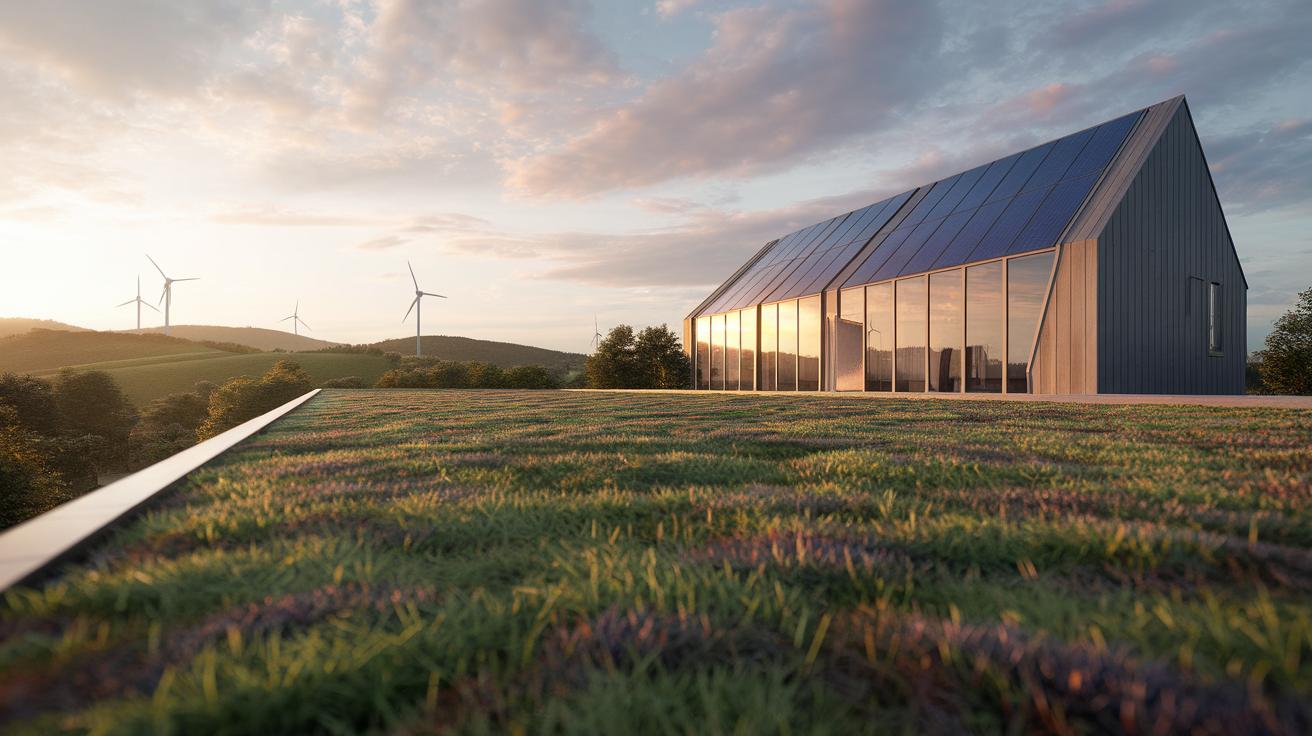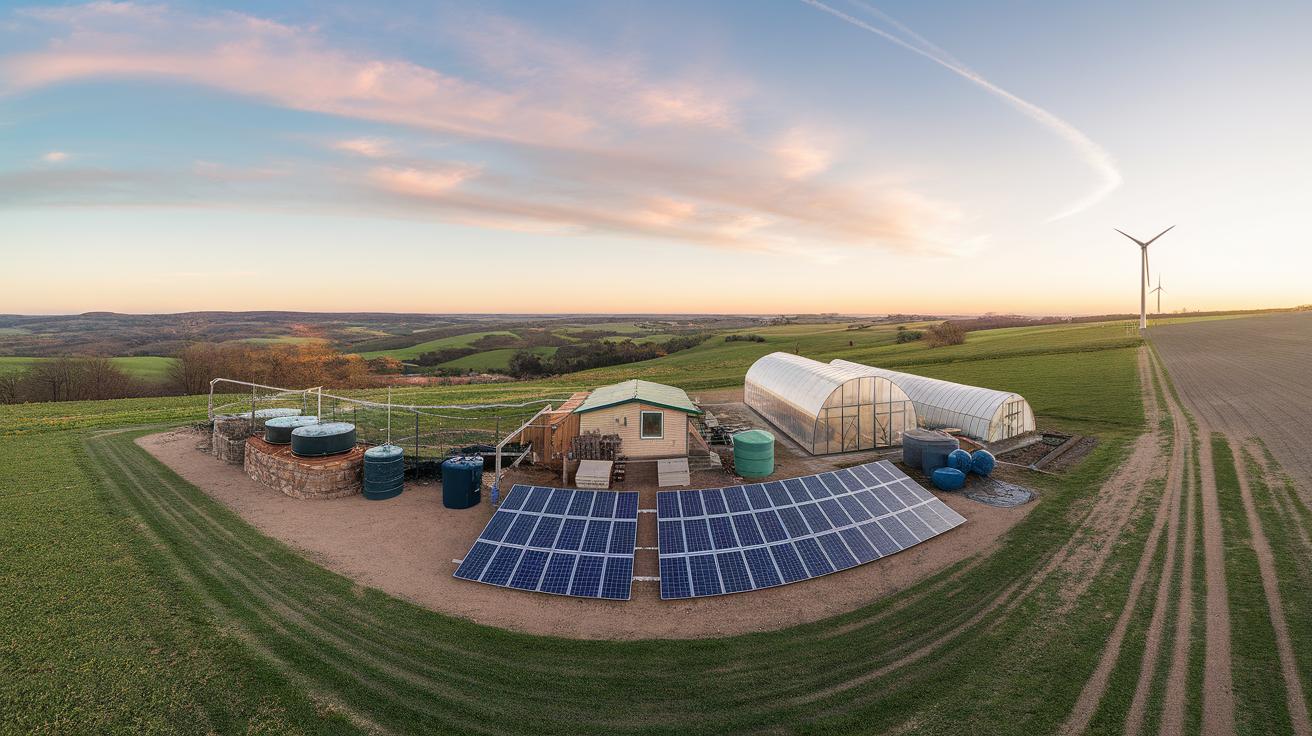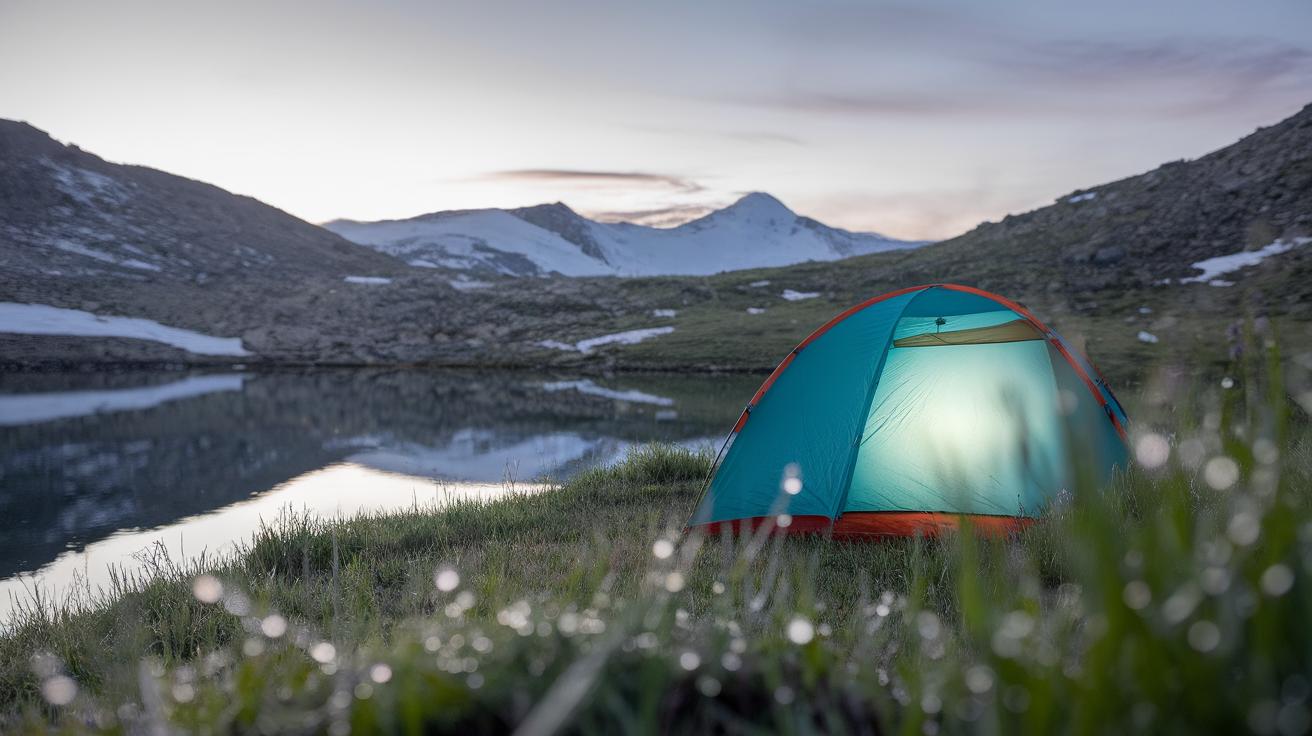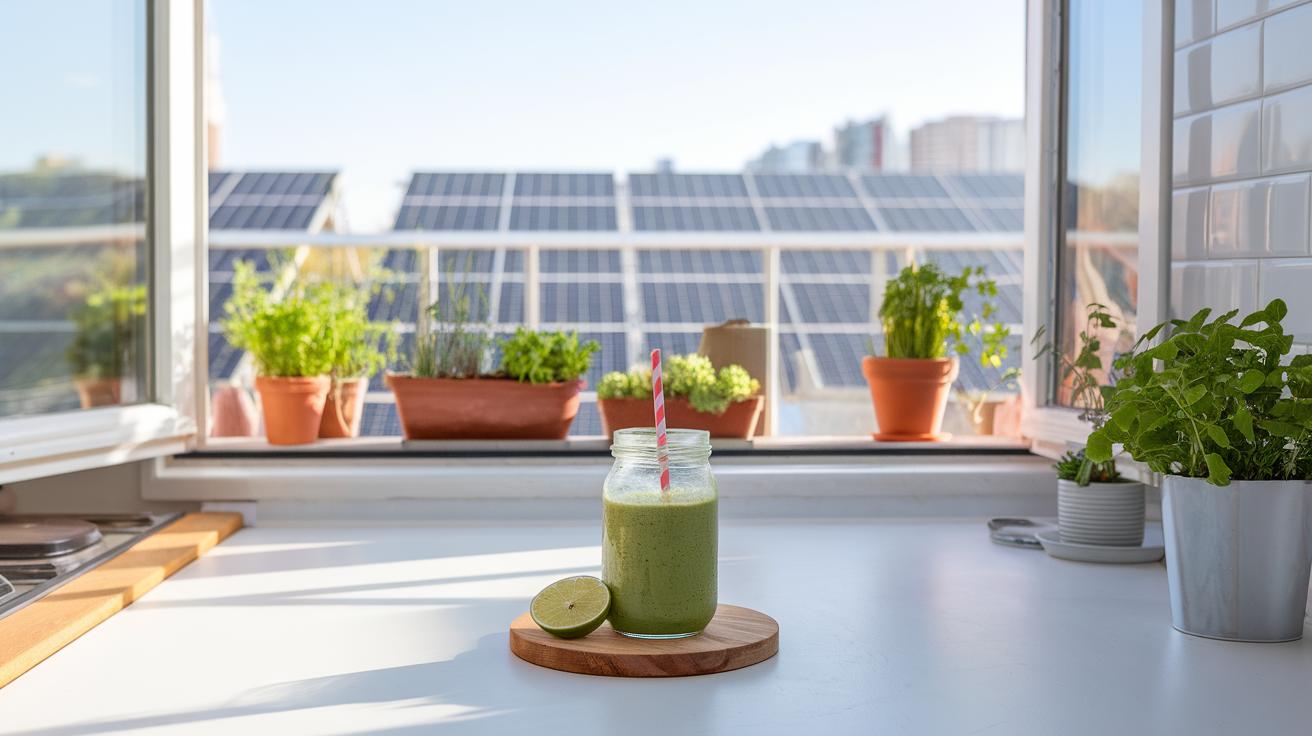Introduction
Eco houses have become key in reducing environmental impact and promoting sustainable living. These homes use technologies and materials that lower energy use and carbon footprint. You can find features like solar panels, insulation, rainwater harvesting, and natural building materials in eco houses. These features help conserve resources, reduce waste, and provide a comfortable living environment. Learning about eco houses gives you insights into how to build and live more sustainably.
Innovative eco house designs take sustainability further. They use new methods and tools to improve energy efficiency, water use, and environmental impact. Living in an eco house means hands-on efforts to minimize your ecological footprint. This article explores different features of eco homes and practical ideas you can apply. It offers actionable advice on how to create a sustainable home and lifestyle that benefits you and the planet.
Understanding Eco Houses and Their Designs

An eco house focuses on lowering energy use and reducing harm to the environment. Its purpose is to create a comfortable living space that uses fewer resources than traditional homes. Unlike standard houses, eco houses include design choices that cut down on heating, cooling, and electricity needs.
Key features often include thick insulation to keep warmth in during winter and out during summer. Thermal mass materials like concrete or brick store heat during the day and release it at night, balancing indoor temperatures naturally. Passive solar orientation positions the home to capture sunlight in cold months while limiting heat gain in warm months. Choice of materials matters too, favoring those with low environmental impact and long life spans. These design elements work together to lower your home’s energy demand and carbon footprint.
Key Eco House Features
You will find double or triple-glazed windows in eco houses to reduce heat loss. These windows have multiple layers of glass separated by air or gas, improving insulation and cutting energy bills.
Mechanical ventilation with heat recovery brings fresh air inside while capturing warmth from outgoing air. This keeps air quality high without wasting energy to heat or cool the entire house.
Renewable heating sources such as solar panels, ground-source heat pumps, or biomass boilers replace fossil fuels. They reduce emissions and often save money over time.
Each feature plays a role in keeping your home comfortable year-round without excessive energy use.
How Design Impacts Energy Use
Site orientation shapes how much sunlight your home receives. Facing the main living areas south (in the northern hemisphere) maximizes winter sun and cuts heating needs. Limiting windows on the north side reduces heat loss.
Glazing impacts how much solar energy enters your home. Using the right type and size of windows lets in warmth when needed and blocks glare or overheating during summer.
Insulation acts like a barrier to heat flow. It keeps your home warm in winter and cool in summer. Proper ventilation removes excess moisture and stale air but can also let heat escape if not designed well.
Designing your home with these elements in mind lets you use natural resources efficiently. What choices can you make in your home’s design to lower energy use starting today?
Materials That Reduce Your Homes Carbon Footprint
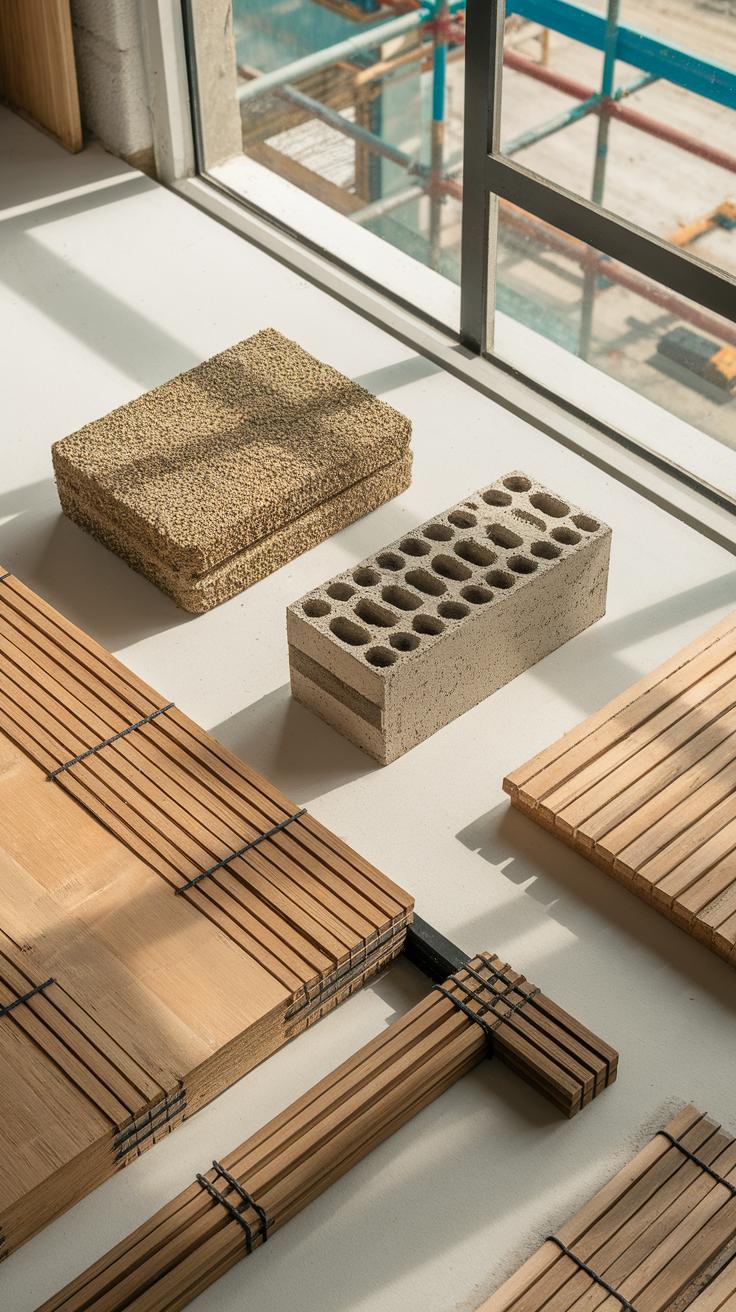
You can lower your eco house’s carbon footprint by choosing the right materials. Natural wood, especially when sourced locally or from certified forests, stores carbon and uses less energy to produce than concrete or steel. Bamboo grows quickly and regrows after harvest, making it a strong, renewable option for flooring or structural elements. Look for recycled materials like reclaimed wood, steel, or bricks to give waste a second life and cut down on new resource use.
Avoid plastics such as PVCu, which release harmful chemicals during production and disposal. Instead, select materials that break down naturally or can be reused easily. Non-toxic products matter for both your health and the environment. Using natural oils and water-based finishes keeps indoor air clean. Choosing materials without harmful chemicals helps you breathe easier and creates a safer living space.
Choosing Sustainable Materials
Select materials with a low environmental impact by checking where and how they come from. Does the material require a lot of energy to produce? Can it last a long time without breaking down? Durable products reduce waste because you won’t need to replace them often.
Consider whether the material can be recycled or reused after your home no longer needs it. For example, wood can be repurposed or composted, while certain metals can be melted down and used again. Ask yourself: Will this choice minimize future waste? Choosing sustainably means thinking beyond the initial build.
Avoiding Harmful Substances
Many building materials release chemicals that harm your health over time. Formaldehyde, found in some plywood and insulation, can cause headaches and respiratory problems. Instead, pick natural, breathable insulation like sheep’s wool or cellulose. These alternatives trap heat while allowing moisture to escape, reducing mold and improving indoor air quality.
Materials without synthetic chemicals create a safer home environment. Using non-toxic paints, sealants, and adhesives supports your well-being and protects the earth. When building or renovating, ask: Are these products safe to live with every day? Choosing natural means choosing health for you and your family.
Energy Efficiency Through Insulation and Ventilation
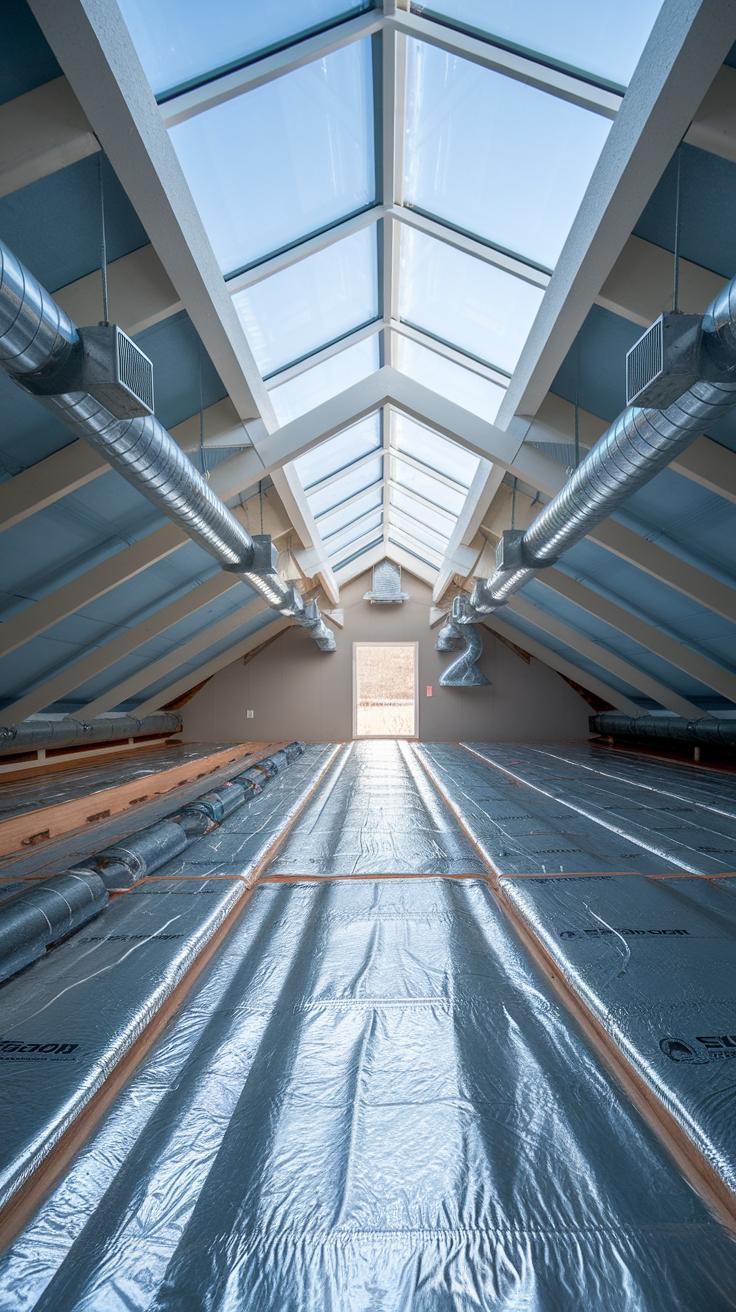
Your home’s comfort depends largely on how well it keeps heat in during winter and lets heat out in summer. Insulation plays a key role by forming a barrier that slows down heat movement. This reduces the need for heating and cooling, saving energy and lowering bills. Eco houses often use airtight construction to prevent warm or cool air from escaping. Sealing cracks around doors, windows, and walls boosts insulation’s effectiveness.
Different insulation materials suit walls, roofs, and floors depending on your design and climate. For example, cellulose made from recycled paper offers good thermal resistance and is eco-friendly. Rigid foam boards provide higher R-values for tight spaces, while sheep’s wool adds natural moisture control. Choosing the right insulation means you use less energy to keep your home comfortable all year.
Ventilation systems are essential for fresh air without wasting energy. Mechanical ventilation with heat recovery takes stale indoor air and transfers most of its heat to incoming fresh air. This keeps rooms well-ventilated and maintains warmth without extra heating. Such systems prevent moisture buildup and improve indoor air quality, the kind of balance that eco-conscious living demands.
Insulation Types and Benefits
Walls, roofs, and floors all need proper insulation to perform well. Fiberglass batts offer R-values from R-13 to R-21 and often work for wall cavities. Spray foam can reach R-6 per inch and seals gaps, blocking drafts. For floors, rigid foam boards with R-10 or higher help stop cold creeping from the ground.
You may wonder how much difference good insulation makes. Adding just a few inches can cut heating and cooling costs by 20 to 30 percent. Each degree your home’s temperature stays stable means less work for your furnace or air conditioner. That saves money month after month and makes your eco home more self-sufficient.
Ventilation Systems That Save Energy
Airtight homes need fresh air to stay healthy. Mechanical ventilation with heat recovery (MVHR) swaps stale indoor air with outdoor air while capturing up to 90 percent of the heat. This process keeps your home cozy during cold weather and cool in the summer without wasting energy.
This system runs quietly and continuously, helping avoid stuffy rooms and moisture problems. You might ask, “Can this be installed in any home?” Many eco house designs plan for MVHR from the start, but retrofit options exist too. Proper ventilation improves comfort and saves energy, making it a practical part of sustainable living you can build into your lifestyle.
Harnessing Solar Energy for Sustainable Living
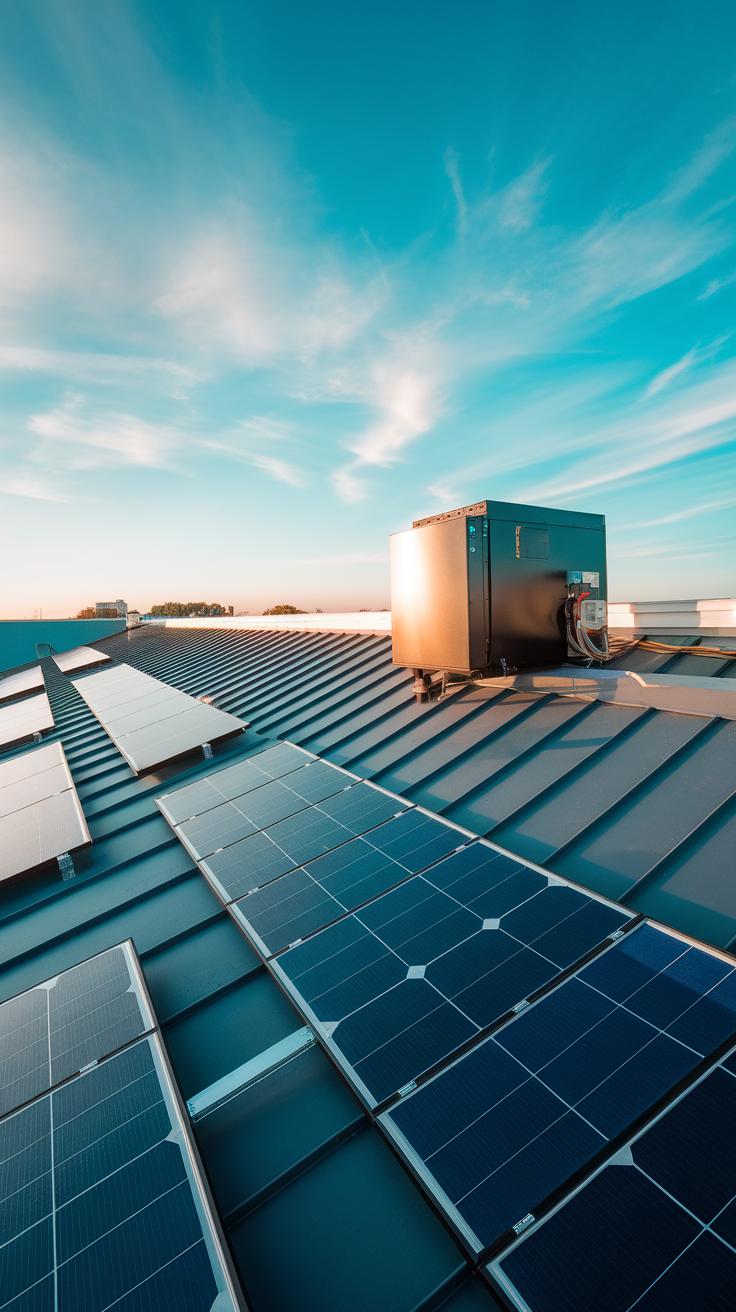
Your eco house can use the sun’s power to cut energy costs and reduce environmental impact. Passive solar design involves placing south-facing windows to capture sunlight during colder months. Thick materials like concrete or stone inside the home act as thermal mass, soaking up warmth during the day and releasing it when temperatures drop. This method helps maintain stable indoor temperatures without relying on heating systems.
In contrast, active solar energy uses technology such as solar panels to convert sunlight into electricity or heat water. These systems work best when integrated with your home’s electrical and heating setups. Combining both passive and active solar strategies can increase your home’s energy independence, lower utility bills, and reduce reliance on fossil fuels. How might your daily life change with less dependence on outside energy sources?
Passive Solar Design Techniques
Window placement shapes your home’s energy use. South-facing windows let in light and warmth during winter but can overheat rooms in summer if not shaded properly. You can use roof overhangs, shutters, or trees to block high summer sun while allowing low winter sun to enter.
Using materials with high thermal mass inside walls or floors stores heat during the day. Brick, concrete, and tile work well. Insulation around thermal mass areas keeps that stored heat inside longer. This combo lowers the need for heating in winter and helps avoid cooling in summer, improving comfort all year.
Using Solar Panels Effectively
There are two main types of solar panels: monocrystalline and polycrystalline. Monocrystalline panels usually deliver higher efficiency, but cost more. Polycrystalline panels offer a good balance between price and output. Thin-film panels exist but typically generate less power and take up more space.
When deciding where to install panels, choose a roof area that faces south with minimal shading. Tilt angle matters; it should reflect your location’s latitude to maximize sunlight exposure. You can estimate your home’s energy needs by tracking past electricity use and calculating how many panels you require. Monitoring energy production and savings after installation helps you adjust habits and potentially add storage solutions for better energy management.
Water Conservation Strategies in Eco Houses

Your eco house can cut water use significantly by using systems like rainwater harvesting, greywater recycling, and low-flow fixtures. These techniques lower the demand on city water supplies and reduce costs on your bills.
Collecting rainwater captures free water from natural rainfall before it runs off or evaporates. Greywater recycling lets you reuse water from sinks, showers, and laundry safely instead of sending it to waste. Low-flow fixtures reduce the water used per task without affecting performance. Together, these systems lighten the load on municipal resources and offer you more control.
How much water do you waste daily without realizing it? Implementing these strategies helps you shrink your home’s environmental footprint. This approach supports your independence from overburdened water systems and grows your role in conserving a vital resource while living sustainably.
Collecting and Using Rainwater
Rainwater harvesting begins with directing water from your roof into gutters and downspouts. This water moves through filters to remove debris and contaminants before it reaches storage tanks or barrels. You can store rainwater above or underground depending on your space and climate.
You can use collected rainwater for outdoor tasks like watering gardens, washing vehicles, or filling pools. With proper filtration and treatment, it can also supply toilets and laundry, cutting your use of potable water. Systems that include first-flush diverters improve water quality by discarding initial runoff that carries dirt and pollutants.
Could your garden thrive solely on rainwater? Adopting rainwater collection turns natural precipitation into a valuable resource, freeing you from relying heavily on treated water and lowering your water bills.
Recycling Greywater
Greywater comes from showers, sinks, and laundry but excludes toilet waste. Collecting greywater requires a separate pipe system that sends this used water to a treatment system. Simple filters remove hair and particles, while more advanced setups use biological or chemical treatment to cleanse the water for reuse.
You can reuse treated greywater safely for irrigating non-food plants, landscapes, or flushing toilets. This reduces the demand for fresh water and cuts down wastewater sent to treatment plants. Systems tailored to your home size and needs balance reuse with health standards to ensure safety.
How might your water footprint shrink if you reused greywater every day? Using this resource wisely helps you run your eco house with fewer demands on municipal infrastructure and supports water conservation in your community.
Smart Technology and Automation for Eco Homes

Smart home technology helps you use energy more efficiently. Programmable thermostats learn your daily routine and adjust heating or cooling to save power. Lighting controls switch off lights when rooms are empty or dim them in the evening. These systems reduce energy waste without asking for extra effort from you.
Automation manages resources by reacting to real-time data. For example, smart blinds can open to capture sunlight in winter and close to keep heat out in summer. Water pumps and ventilation fans can run only when needed, cutting down utility bills. You can control many devices remotely, making eco-living practical and flexible.
How often do you leave lights on or forget to change your thermostat? Smart automation can help solve these common problems and keep your eco home running smoothly. It transforms sustainability from an idea into everyday action.
Managing Energy with Smart Devices
Smart thermostats, like Nest or Ecobee, adjust temperature based on when you are home or asleep. This prevents heating or cooling unused rooms. For example, your thermostat can lower heat during work hours and warm up again in time for your return. This reduces energy use without sacrificing comfort.
Smart lighting options include Philips Hue and LIFX bulbs. They dim or turn off automatically when rooms are empty. Some systems also change light color to sync with natural daylight, improving mood and reducing eye strain. You may notice lower electric bills by matching light use to actual need.
What if your lights only turned on when you walked into a room? How much energy would you save? These technologies put control in your hands, encouraging mindful use of power every day.
Monitoring and Reducing Waste
Home energy monitors, like Sense or Emporia, track how much electricity each appliance uses. This helps you spot energy hogs and change habits. For instance, you might learn that an old fridge runs constantly and consider upgrading it for efficiency.
Leak detectors protect water and electricity. They sense unusual water flow from pipes or unexpected power surges. Early alerts prevent costly waste and damage. Fixing leaks quickly saves money and conserves resources.
Have you measured your home’s energy use closely? Monitoring gives you the data to make smart decisions. Reducing waste becomes a clear goal instead of a guess. Smart tools turn your eco home into a responsive, resource-saving environment.
Growing Food and Green Spaces at Home
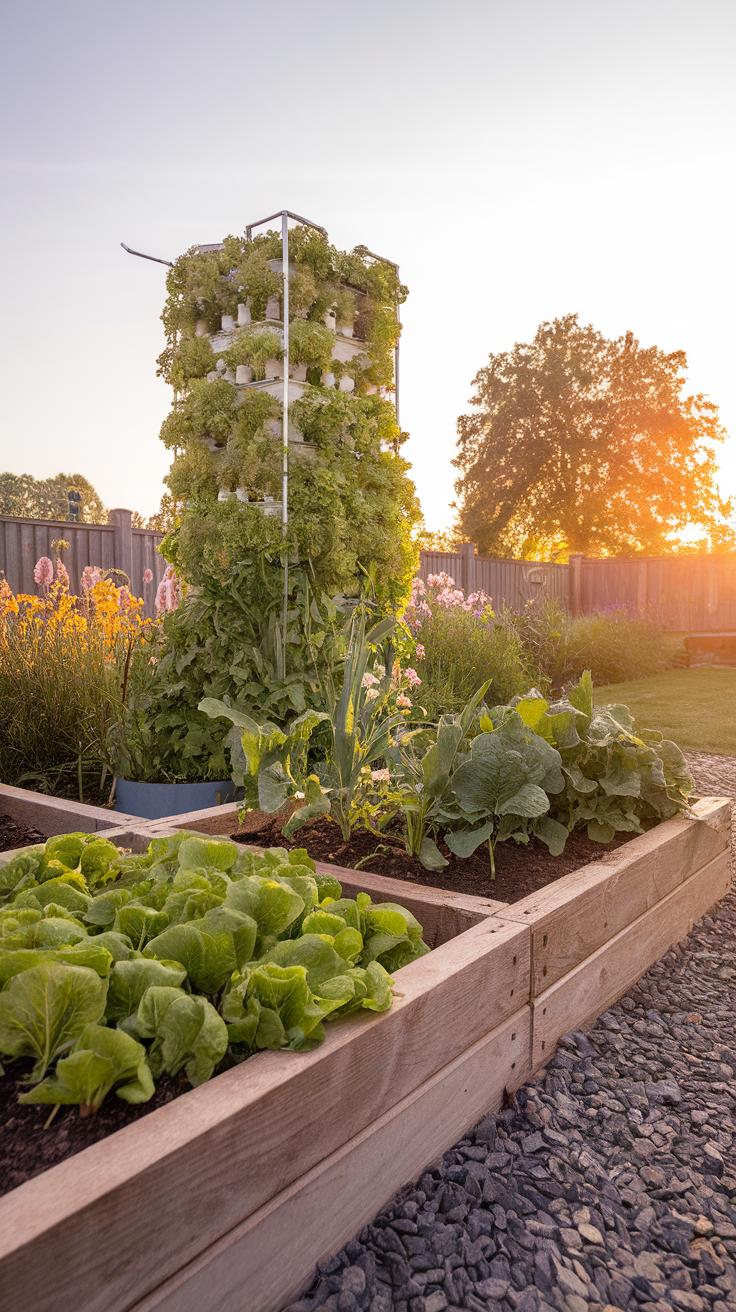
Creating a vegetable garden at home connects you directly with your food source. Every seed planted offers control over what you eat and reduces trips to the store. Homegrown vegetables avoid packaging waste and long-distance transport. This cuts your carbon footprint while boosting your health with fresh produce. You learn how your food grows and how to nurture the soil, making sustainability a hands-on experience.
Green roofs add a living layer atop your house. They help keep your home cooler in summer and warmer in winter by naturally insulating it. This reduces energy costs for heating and cooling. Green roofs also capture rainwater, easing pressure on storm drains while providing habitats for birds and insects. Inside, plants improve air quality by filtering toxins and releasing oxygen. Your indoor greenery can lift moods and increase focus while helping clean the air you breathe.
Combining gardening with eco house design makes green living practical. Consider rooftop planters to grow vegetables or herbs. Use window spaces for pots or vertical gardens. Integrate rainwater collection for irrigation. Ask yourself: How can I redesign my home’s spaces to support life indoors and out? This approach makes your eco house more than a structure; it becomes part of a living system where you grow food, improve air quality, and live more sustainably.
Starting a Home Vegetable Garden
Start by choosing a sunny spot with good soil or build raised beds if your soil is poor. Pick vegetables that match your climate and the growing season. Tomatoes, lettuce, and carrots work well for many beginners. Plant seeds or seedlings based on instructions for depth and spacing.
Water your garden regularly but avoid overwatering. Mulch around plants helps keep moisture steady and reduces weeds. Keep an eye out for pests and practice natural control methods, like companion planting or neem oil.
Growing your own food reduces grocery costs and food waste. You’ll know exactly what pesticides or fertilizers are used. Plus, gardening gives you a chance to spend time outside, feel connected to nature, and develop new skills. What vegetables do you want to try growing this season?
Green Roofs and Indoor Plants
Green roofs act as a natural barrier to heat and cold. Layers of soil and plants absorb sunlight and reduce the heat that reaches your house. This helps lower cooling bills in summer and warms your home during winter. Research shows green roofs can cut energy use by up to 25 percent in some climates.
Indoor plants help remove harmful chemicals like formaldehyde and benzene from the air. Plants such as spider plants, snake plants, and pothos work well indoors. They also raise humidity and reduce dust levels, which benefits your respiratory health.
Placing plants near windows, or creating small indoor gardens, adds life to your space. Have you thought about using plants to improve your home’s air and comfort? Incorporating green roofs along with indoor plants connects your living environment to natural cycles and supports sustainable living every day.
Practical Steps to Build Your Own Eco House
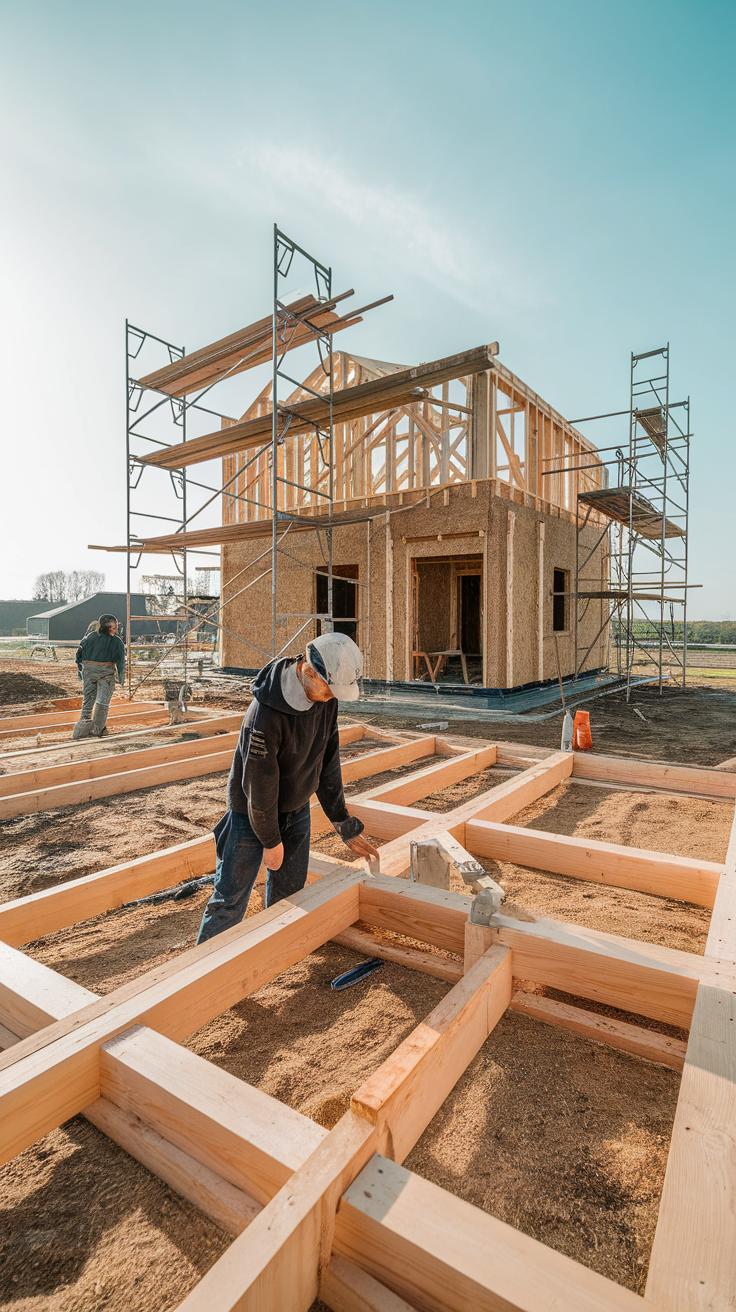
Planning and Design Considerations
Begin by studying your land carefully. Observe the sunlight, wind direction, and natural shading. How will these elements affect heating, cooling, and lighting inside your home? Think about your daily routines and the number of people living in your house. What rooms do you need most? How much storage or workspace will support your lifestyle?
Focus on creating a simple, compact design to reduce energy use. Position larger windows to capture sunlight during colder months and smaller ones where heat gain might be a problem. Consider how your green spaces from the previous chapter will connect with the house’s layout. Your design should take advantage of natural elements to make your living space comfortable without relying heavily on artificial energy.
Construction and Material Choices
Choose builders who understand eco-friendly methods like passive solar design, efficient insulation, and natural ventilation. Ask for examples of previous projects to ensure they can meet your goals. Use materials that come from sustainable sources, such as reclaimed wood, bamboo, or recycled metal. These materials reduce waste and lower environmental impact.
Select low-toxicity finishes and paints to improve indoor air quality. Think about systems that waste less energy, like solar panels, rainwater harvesting, or greywater recycling. Talk openly with your professionals about your budget and priorities to find solutions that balance cost and sustainability. What trade-offs are you willing to make to build a home that supports your eco-friendly lifestyle?
Living Sustainably in Your Eco House

Every day in your eco house offers chances to reduce your impact on the environment. Simple choices around energy and water use make a big difference. Turning off lights and electronics when not in use can cut electricity waste. Using natural light during the day lowers the need for artificial lighting. Setting your thermostat a few degrees lower in winter and higher in summer helps save energy while keeping comfort.
Water-saving habits include fixing leaks quickly and installing low-flow faucets or showerheads. Collecting rainwater for garden use reduces the strain on public water systems. Washing clothes in cold water and running full loads also helps conserve water and energy. Have you tracked your monthly water and electricity use? Monitoring this can reveal where you can improve.
Energy and Water Conservation Habits
You can easily conserve energy by unplugging devices that are not in use. Many appliances draw small amounts of power even when turned off. Switching to LED bulbs greatly reduces electricity use and lasts longer than traditional bulbs. Using smart power strips helps manage multiple electronics at once.
Lower your water use by turning off the tap while brushing your teeth or washing dishes. Fixing even minor drips saves gallons over time. Installing rain barrels captures water for outdoor plants. Consider energy-efficient appliances that consume less water and power. Small efforts like these reduce bills and environmental impact simultaneously.
Waste Reduction and Composting
Sorting your trash into recyclables, compost, and landfill waste keeps materials out of the dump. Separate paper, plastics, and metals to place in recycling bins. Composting food scraps and yard waste turns what would be trash into valuable soil conditioner.
Set up a compost bin in your yard or use a compost tumbler for easy mixing. Add fruit peels, coffee grounds, and leaves but exclude meat and dairy to avoid odors. Rich compost improves your garden soil, supporting healthy plants without chemical fertilizers. How much waste does your household create weekly? Reducing what goes into trash bins can save space and enrich your garden simultaneously.
Conclusions
Eco houses offer many benefits. They save energy, reduce pollution, and create healthier living spaces. Their designs focus on insulation, solar energy, water conservation, and sustainable materials. These elements work together to reduce environmental harm and cut costs. You can take inspiration from eco house features to make your home more eco-friendly. Small changes add up to big impacts in sustainability.
Innovative eco house designs show what the future of housing can be. They blend technology with natural resources and smart planning. Living sustainably is more than a trend; it is a responsible way to care for the environment. You have the power to choose materials, systems, and habits that support green living. This article encourages you to take practical steps towards building or upgrading an eco house that fits your lifestyle and values.


